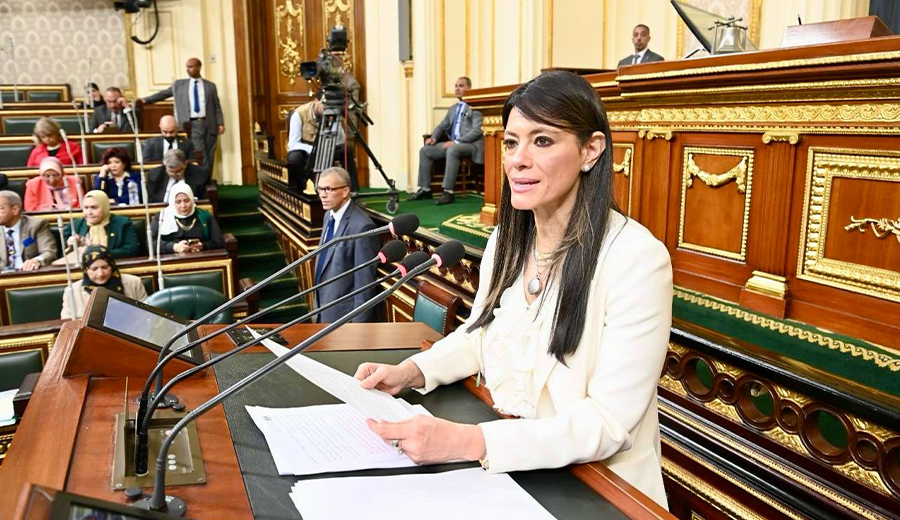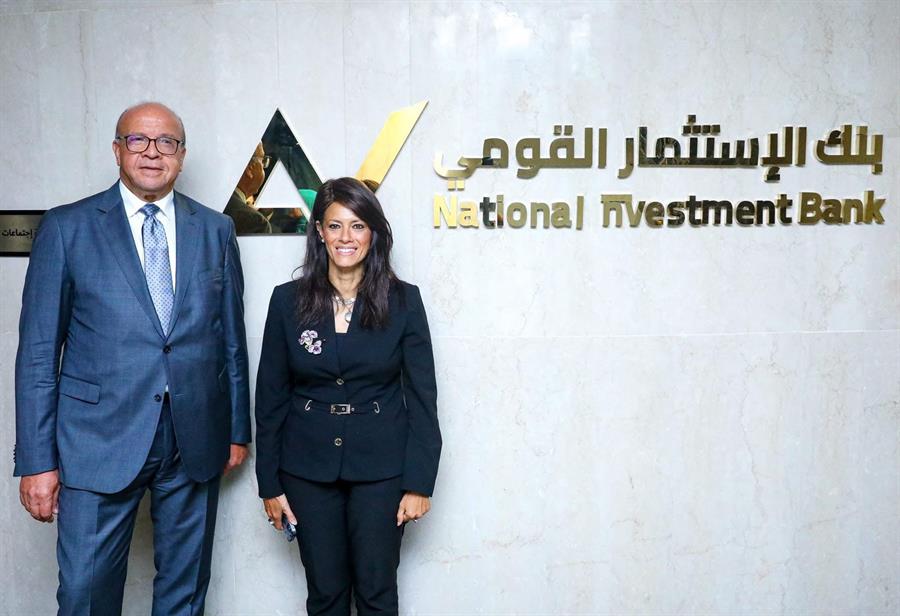Minister of Planning, Economic Development and International Cooperation Reviews the Economic and Social Development Plan for the Next Fiscal Year at the House of Representatives' Plenary Session

15 April 2025
Corrective Fiscal and Monetary Policies and Governance of Public Investments Enhance the Notable Improvement in the Egyptian Economy's Performance
EGP 20.4 Trillion Value of GDP at Current Prices in Fiscal Year 2025/2026 (at Constant Prices)
We Expect Investment Spending and Net Exports to Contribute the Largest Share to Growth Rates in the New Fiscal Year's Plan
For the First Time.. EGP 3.5 Trillion Total Targeted Investments, Representing 17.1% of GDP
Increase in Private Investments to EGP 1.94 Trillion, Representing 62.7% of Total Investments
H.E. Dr. Rania A. Al-Mashat, Minister of Planning and
Economic Development and International Cooperation, stated that the
government's reform interventions, implemented since March 2024 at the level of
fiscal and monetary policies and the governance of public investments, have led
to a notable improvement in the performance of the Egyptian economy in recent
times.
This came during the Minister's review of the targets and
main features of the draft Economic and Social Development Plan for the fiscal
year 2025/2026, within the framework of the medium-term plan (2025/2026 –
2028/2029), before the House of Representatives today, chaired by H.E.
Counselor Dr. Hanafy Gebaly, and in the presence of the esteemed members of the
House.
Improvement in Macroeconomic Indicators
The Minister highlighted the notable improvement in economic
growth during the first and second quarters of the current fiscal year, rising
from 3.5% to 4.3%, with expectations of reaching around 4.1% and 4.2% in the
third and fourth quarters, respectively, bringing the economy's growth rate to
4% by the end of the year.
This was driven by the achieved growth in key sectors,
particularly non-oil manufacturing industries, alongside the recovery of the
tourism sector and the growth of the communications and information technology
sector. This growth is also attributed to the Egyptian government's adoption of
clear policies to consolidate macroeconomic stability, in addition to enhancing
the governance of investment spending and slowing the growth of public
investments in favor of creating space for private sector investments.
H.E. Dr. Al-Mashat added that the manifestations of
improvement in the Egyptian economy's performance also include the growth of
tourism revenues to $4.8 billion in the first quarter of fiscal year 2024/2025,
compared to $4.5 billion in the corresponding quarter of fiscal year 2023/2024,
and the narrowing of the decline in Suez Canal revenues during the last three months
of 2024 from 63% in October 2024 to 59.2% in December 2024, until the rate of
decline reached 23.8% in February 2025. Additionally, foreign exchange reserves
at the Central Bank of Egypt increased on an annual basis to record $47.4
billion at the end of February 2025, compared to $35.3 billion in February
2024, a growth rate of about 34%.
H.E. Dr. Al-Mashat outlined that among the manifestations of
this improvement is the continued containment of inflation, particularly with
its downward trend last March due to the base period effect, while continuing
to monitor and review energy prices according to global developments and local
production costs.
Furthermore, the value of remittances from Egyptians working
abroad increased to $17.1 billion in the first half of fiscal year 2024/2025,
compared to $9.4 billion in the corresponding period of fiscal year 2023/2024.
There was also a surge in net foreign direct investment from $10 billion in
fiscal year 2023/2024 to $46.1 billion in fiscal year 2024/2025.
Targets of the Economic and Social Development Plan for the
Next Fiscal Year
H.E. Dr. Rania Al-Mashat reviewed the targets of the
2025/2026 plan, emphasizing that an economic growth rate of around 4.5% is
estimated to be achieved, which is a relatively high rate compared to the
modest rate of 2.4% recorded in 2023/2024 due to the direct impact of economic
and geopolitical crises. Targeting this rate also reflects a positive direction
for continuing recovery from their repercussions.
H.E. Minister Al-Mashat stressed the importance of
monitoring the repercussions of geopolitical and economic developments in the
Middle East and the world, and the uncertainty they impose, due to the
potential negative impact on the targeted growth rate.
H.E. Dr. Al-Mashat affirmed that GDP is expected to rise to
about EGP 9.1 trillion at constant prices in fiscal year 2025/2026, reaching
about EGP 20.4 trillion at current prices, compared to about EGP 17.3 trillion
expected in fiscal year 2024/2025, an increase of 18%. The three sources of
economic growth will contribute positively and balancedly to achieving the
targeted growth rate of 4.5%, with final consumption expenditure contributing
about 27%, investment spending contributing 37%, and the net change in exports
contributing 36%.
The Minister of Planning and Economic Development and
International Cooperation touched upon the sectoral contributions to GDP for
fiscal year 2025/2026, noting that the wholesale and retail trade, agriculture,
manufacturing industries, real estate activities, transportation, and social
services sectors constitute the drivers of rapid economic growth due to their
large relative weight in GDP and the growth of their commodity and service
activities according to the priority scale set in the plan.
Total Investments for the Next Fiscal Year
H.E. Dr. Al-Mashat pointed to the growth in the targeted
total investments in the plan, reaching EGP 3.5 trillion for the first time,
compared to the expected investments for fiscal year 2024/2025 of about EGP 2.6
trillion, and the actual investments for fiscal year 2023/2024 of EGP 1.8
trillion. She affirmed that these indicators demonstrate the state's conviction
in the important role that investment plays as a fundamental and active driver
of economic growth.
The Minister also emphasized the continued rise in the
investment rate to record 17.1% of GDP in fiscal year 2025/2026, compared to
lower rates in the previous two years, where it reached 15% in fiscal year
2024/2025 and 13% in fiscal year 2023/2024. She pointed to the achievement of
the required balance in the investment contributions of the three sectoral
groups that make up the expected GDP in fiscal year 2025/2026.
H.E. Minister Al-Mashat added that private investments are
expected to increase to about EGP 1.94 trillion, with a contribution rate of
62.7% of the total, compared to 37.3% for public investments, in light of the
state's direction to support efforts aimed at accelerating the pace of private
sector growth while emphasizing the principles of good governance and
competitive neutrality.
H.E. Dr. Al-Mashat also referred to the allocation of
approximately EGP 1.16 trillion as targeted public investments in the 2025/2026
plan, compared to expected investments in 2024/2025 of around EGP 1 trillion. This
is within the framework of the state's commitment to the credit ceiling set in
this regard to the governance of public investments, reduce the debt burden
resulting from servicing domestic and foreign public debt, and provide wider
areas for private sector participation in development efforts. The distribution
structure of public investments reveals that government agencies account for
37.6%, public economic authorities for 43.3%, compared to 19.1% as local
investments at the level of governorate general directorates.
She affirmed that the 2025/2026 plan generally aims to
continue raising the efficiency of public investment, both in the planning and
resource allocation phase and in the implementation follow-up and performance
evaluation phase, by emphasizing the importance of adhering to the proposed
mechanisms for developing and raising the efficiency of public investments.
H.E. Minister Al-Mashat added that follow-up and performance
evaluation work, according to the programs and performance methodology,
includes monitoring the implementation of the plan in line with the targets of
Egypt's Vision 2030 and the government's work program, monitoring the
indicators of sectoral strategies and verifying their alignment with the plan's
targets, monitoring the impact of public investment on improving international
indicators, monitoring the impact of program implementation on localizing
sustainable development in the governorates, evaluating the plan's impact on
the transition to a green economy, in addition to evaluating the plan's impact
on considering social priorities.









